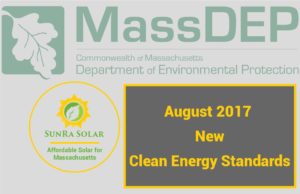Solar News & Information
New Massachusetts Clean Energy Standard
August 18, 2017
On August 11, 2017, the Massachusetts Department of Environmental Protection announced new regulations to comply with the newest and most ambitious state law. The general announcement can be seen here at the Boston Globe.
At SunRa Solar, Inc., we are constantly on the lookout for anything that affects solar energy costs or solar technology. So, as the ink is drying on the legislation and corresponding regulations, we take a look at the most important changes and describe their impact.
Global Warming Solutions Act
Beginning in 2008, the state finalized the most recent version of the Global Warming Solutions Act (GWSA). As recently as 2016 the statutory requirements and compliance measures were contested for clarity in the courts. Here is a brief and more complete GWSA explanation of the details that we highlight below:
- The original law in 2008 set a goal to reduce green house gas (GHG) emissions 25% by the year 2020. This target is proving to be a challenge for state utilities and has compliance has been argued in court.
- The statute was designed to be more far reaching. To to that it established a more aggressive goal, requiring the state to reduce total emissions 80% by 2050, using 1990 as the baseline. Said another way, by 2050 the state must emit 20% of the 1990 levels of GHG.
- The requirements of the Regional Greenhouse Gas Initiative (RGGI) are incorporated.
The Renewable Portfolio Standard
As far back as 2002, the state of Massachusetts established a Renewable Portfolio Standard (RPS), requiring all retail electricity suppliers to provide a minimum percentage of kilowatt-hour (kWh) sales from renewable energy.
- The program began requiring only 1% of sales to come from renewable sources.
- To meet the 2020 target of 15% of sales, the program gradually escalated by about 1% per year.
- From 2020 to 2050, the RPS requires a 2% escalation per year. By 2050 the current standard requires that 80% of sales of electrical power come from renewable energy sources.
The Bottom Line – Massachusetts Clean Energy Standard
In order to properly meet the codified standards, the Massachusetts Department of Environmental Protection (DEP) issued new rules and regulations. Both the GWSA and RPS requirements are factored in.
Here is a quick summary of the August 11, 2017 final communication:
- Existing power plants are given CO2 emission limits. They are as a low as approximately 1,600 metric tons per year (Medway Station) and as high as approximately 1,500,000 metric tons per year (Mystic). Clearly the size of the facility impacts the emission limits.
- The combined total of new generating facilities will be limited to 1.5 million metric tons of CO2.
- It further requires that between 2018 and 2050 there is an overall 80% reduction of CO2 emissions from all power generation, a number conveniently equal to the RPS clean energy target.
What Does This Mean for the Homeowner?
Every rule and every regulation has a bottom line impact on the operation of traditional power generating facilities. Now that the utilities can plan around the newly locked future limits, the will begin planning their strategy.
This leaves power companies with two avenues for compliance. They may make significant investments in large renewable energy facilities, both solar and wind. As of today, for example, offshore wind in now becoming a reality for coastal Massachusetts. But they also have the option of buying addition Renewable Energy Credits (REC) and especially Solar RECs (SRECs).
At SunRa Solar we think this will guarantee a strong market for the SRECs and a great value for homeowners who chose solar energy systems.
Keep an eye on this page as we update you with more details and analysis!
Contact Us with questions or to see exactly how solar power will work for YOUR home, saving you thousands. It’s a free evaluation with absolutely no obligation.


